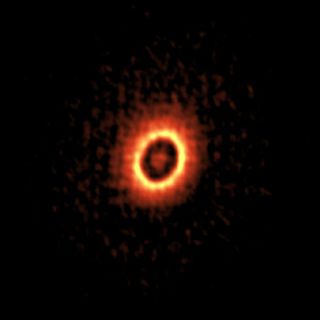
A solar system similar to our own may be taking shape in the Taurus constellation.
The young star DM Tau, which lies about 470 light-years from Earth, was already known to host a ring of dust where planets are likely forming. But recent observations by the powerful Atacama Large Millimeter/submillimeter Array (ALMA) in Chile show there's considerably more to the story.
"Some studies suggested the radius of the ring is about where [our] solar system's asteroid belt would be. Other observations put the size out where Neptune would be," Tomoyuki Kudo, an astronomer at the National Astronomical Observatory of Japan, said in a statement.
"Our ALMA observations provided a clear answer: Both are right," added Kudo, the lead author of a recent study reporting the results. "DM Tau has two rings, one at each location."
Related: Meet ALMA: Amazing Photos from Giant Radio Telescope
The team further identified a bright patch in the outer ring — a conglomeration of dust where a Neptune-like world may be coming together around DM Tau, which is thought to be 3 million to 5 million years old and half as massive as Earth's sun.

"We are also interested in seeing the details in the inner region of the disk, because the Earth formed in such an area around the young sun," co-author Jun Hashimoto, a researcher at the National Institutes of Natural Sciences' Astrobiology Center in Tokyo, said in the same statement. "The distribution of dust in the inner ring around DM Tau will provide crucial information to understand the origin of planets like Earth."
Get the Space.com Newsletter
Breaking space news, the latest updates on rocket launches, skywatching events and more!
This is far from the first exoplanet baby picture captured by ALMA, a network of radio telescopes in northern Chile's Atacama Desert. ALMA has spotted similar dust rings around many stars, giving astronomers key glimpses at the planet-formation process.
The DM Tau results were published in November in The Astrophysical Journal Letters. The team also presented the study this month at the annual meeting of the Astronomical Society of Japan.
- 7 Ways to Discover Alien Planets
- Exoplanets: Latest News About Alien Worlds
- Exoplanet Tour: Meet the 7 Earth-Size Planets of TRAPPIST-1
Mike Wall's book about the search for alien life, "Out There" (Grand Central Publishing, 2018; illustrated by Karl Tate), is out now. Follow him on Twitter @michaeldwall. Follow us on Twitter @Spacedotcom or Facebook.
Join our Space Forums to keep talking space on the latest missions, night sky and more! And if you have a news tip, correction or comment, let us know at: community@space.com.

Michael Wall is a Senior Space Writer with Space.com and joined the team in 2010. He primarily covers exoplanets, spaceflight and military space, but has been known to dabble in the space art beat. His book about the search for alien life, "Out There," was published on Nov. 13, 2018. Before becoming a science writer, Michael worked as a herpetologist and wildlife biologist. He has a Ph.D. in evolutionary biology from the University of Sydney, Australia, a bachelor's degree from the University of Arizona, and a graduate certificate in science writing from the University of California, Santa Cruz. To find out what his latest project is, you can follow Michael on Twitter.
